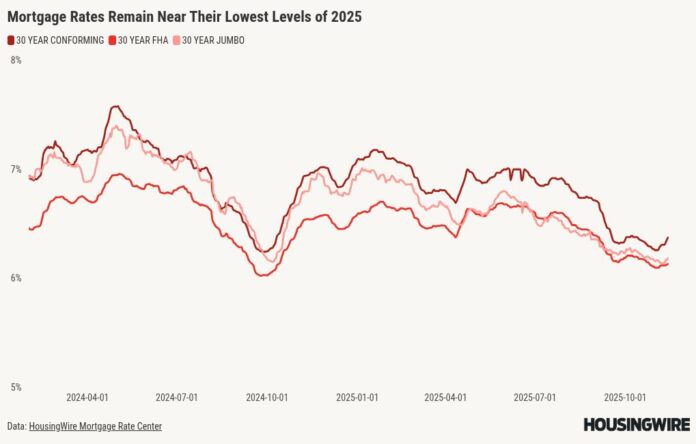Meanwhile, rates for 30-year jumbo loans and 30-year loans backed by the Federal Housing Administration (FHA) — both of which reached year-to-date lows in early November — have risen only slightly in that period. They averaged 6.18% and 6.13% on Tuesday, respectively.
These relatively steady rate movements seem to be in line with market expectations following the Federal Reserve’s 25-bps cut to benchmark rates late last month. The cut was widely anticipated and baked into the rates offered by most mortgage lenders well in advance.
“We’ve seen this rhythm before: rates fall in anticipation of a Fed cut, rise slightly following the announcement due to cautious messaging, and then stabilize or trend down again as economic data unfolds,” said Samir Dedhia, CEO of One Real Mortgage.
“With only one Fed meeting left in 2025 and no guarantee of another cut in December, markets are watching inflation and labor data closely, and that uncertainty continues to influence bond yields and mortgage pricing.”
Will a December rate cut materialize?
In the run-up to last month’s Fed meeting, market observers gave strong odds on another cut to the federal funds rate in December. But fewer bets are being placed today on that side of the roulette wheel.
The CME Group’s FedWatch tool shows that opinions are equally divided as 50% of interest rate traders surveyed say there will another 25-bps cut next month, while the other 50% predict no changes. If benchmark rates do come down another quarter-point, they’ll be at the lowest range seen since November 2022.
At an economic conference in London on Monday, Fed Governor Christopher Waller argued that further rate cuts are a necessity. Waller said that while the recently ended government shutdown made forecasting more difficult, he doesn’t believe Fed policymakers are “flying blind” and have had enough available data to make informed decisions.
“So, what is that data telling us? First, that the labor market is still weak and near stall speed. Second, that inflation through September continued to show relatively small effects from tariffs and support the hypothesis that tariffs are having a one-off effect raising price levels in the U.S. and are not a persistent source of inflation.”
Last month, the Fed confirmed its cut by a 10-2 vote, with Stephen Miran voting for a larger 50-bps cut and Jeffrey Schmid voting for no cut.
50-year mortgages and LLPAs
President Donald Trump and Bill Pulte, director of the Federal Housing Finance Agency (FHFA), have floated some ideas in recent weeks to address affordability hurdles for prospective homebuyers that go beyond the lowering of mortgage rates.
Their proposal to implement 50-year mortgages, however, was met with swift pushback by many housing industry experts, who say that extending loan terms will not make a significant difference. To gain widespread acceptance, the idea would also require an overhaul of the Dodd-Frank Act, which prohibits 40- and 50-year loans under the definition of a qualified mortgage.
HousingWire Lead Analyst Logan Mohtashami said that when accounting for a higher interest rate on a longer loan term, the interest paid on a 50-year, $300,000 mortgage with a 6.80% rate would top $755,000.
That’s more than double the amount paid on a 30-year loan with a 6.32% rate, and the 50-year loan would only save the borrower about $100 per month. The interest payment chasm widens as the loan size rises.
In a column for The Builder’s Daily, real estate developer Scott Finfer also panned the idea as detrimental to household wealth building.
“With a 30-year loan, a homeowner begins to see real equity growth after the first 7-10 years. With a 50-year loan, it might take 15 to 20 years before the principal balance drops meaningfully. That’s two decades of payments without much ownership to show for it,” Finfer wrote.
Pulte also said the FHFA is looking at changes to the loan-level price adjustments (LLPAs) levied by Fannie Mae and Freddie Mac on conventional loan purchases.
Melissa Cohn, regional vice president for William Raveis Mortgage, said in written commentary that she supports an across-the-board repeal of LLPAs. As an example, she noted that these fees can make “condominiums a lot more expensive than single-family homes.”
If LLPAs were removed, “mortgage rates could drop by 25 to 50 basis points without anything happening the bond market,” Cohn added.
